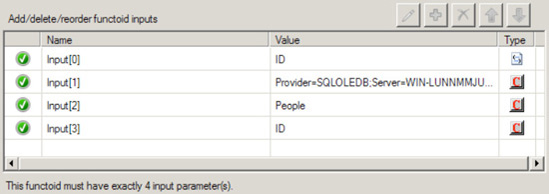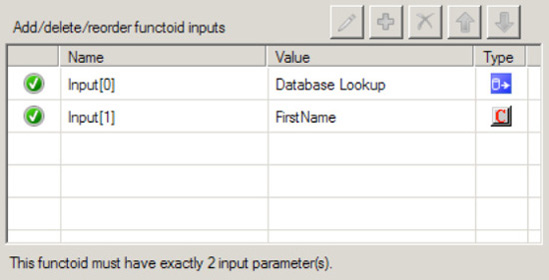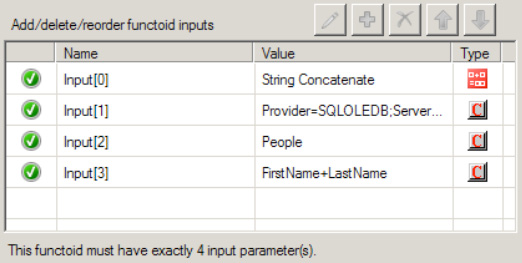1.
Problem
You need to map an incoming
node to a database table column to reference a specific set of data via a
BizTalk Server map. Specifically, for an inbound author ID, you need to retrieve the person attributes that are stored in a SQL based table.
Additionally, the data that is stored in the database table is dynamic,
and coding the values within the BizTalk map is not possible.
NOTE
The Database Lookup
functoid can communicate with any ODBC-compliant data source. For this
recipe, SQL Server is the assumed data source.
2. Solution
BizTalk provides the
Database Lookup functoid, which can retrieve a recordset. For example,
suppose that the inbound message specifies an author's Social Security
number but no personal information. The map must retrieve the author's
information and map the information to the outbound message. The
Database Lookup functoid can retrieve the information from a specific
SQL table using the author's Social Security number as the value for
which to search. The inbound XML message may have a format similar to
the following and a table with data as show in Figure 1.
<ns0:PersonSearch xmlns:ns0="http://DatabaseLookupFunctoid.PersonSearch">
<ID>172321176</ID>
</ns0:PersonSearch>

You can use the Database
Lookup functoid by taking the following steps:
Click the Toolbox, and then click the Database Functoids
tab. On the map surface, in between the source and destination schemas,
drag and drop a Database Lookup functoid.
Connect
the left side of the Database Lookup functoid to the inbound document
node that will specify the value used in the search.
Configure
the input parameters of the Database Lookup functoid, as shown in Figure 2. This functoid requires four
parameters to be specified either through mapping the inbound source
data to the functoid or through setting constants in the functoid.
For
the first input parameter, verify that the inbound node, connected in
step 2, is the first value in the list of properties. This is a value to
be used in the search criteria. It's basically the same as the value
used in a SQL WHERE clause.
Set
the second parameter, which is the connection string for the database.
The connection string must be a full connection string with a provider,
machine name, database, and either account/password or a flag indicating
the use of Trusted Security mode in SQL. The connection string must
include a data provider attribute. A lack of data provider attribute
will generate a connection error when the map tries to connect to the
database.
NOTE
The easiest connection
string to start with is integrated security, which has the format of Provider=SQLOLEDB;Server=[servername];Database=[dbname];Integrated
Security=SSPI;.
Set the third parameter, which is
the name of the table used in search.
Set
the fourth parameter, which is the name of the column in the table to
be used in search.

Again, click the Toolbox, and
click the Database Functoids tab. On the map surface, after the Database
Lookup functoid, drag and drop the Error Return functoid.
Connect the
right side of the Database Lookup functoid to the left side of the Error
Return functoid. Connect the right side of the Error Return functoid to
the outbound schema node that is a placeholder for error messages.
Again,
click the Toolbox, and click the Database Functoids tab. On the map
surface, above the Error Return functoid, drag and drop the Value
Extractor functoid for each extracted value from the return recordset.
For example, if you are returning five values in the recordset, you
would need five Value Extractor functoids.
For
each Value Extractor functoid, connect the left side of the functoid to
the right side of the Database Lookup functoid.
Configure
the properties of each Value Extractor functoid to retrieve the
appropriate value by specifying the column name of the extracted value.
For example, if the value returned resides in a column named FirstName, you would create a constant in the Value
Extractor functoid named FirstName.
The Value Extractor functoid's Configure Functoid Inputs dialog box
should look similar to Figure
3.

For each Value Extractor
functoid, connect the right side of the functoid to the appropriate
target schema outbound node. The completed map should look similar to
the sample map in Figure 4.

3. How It Works
The Database Lookup
functoid requires four parameters as inputs, and it outputs an ActiveX
Data Objects (ADO) recordset. Keep in mind that the recordset returns
only the first row of data that matches the specific criteria provided
to the Database Lookup functoid.
In addition to the
input parameters, the Database Lookup functoid requires two helper
functoids for optimal use:
The Error Return
functoid, which returns SQL-related errors or exceptions. The Error
Return functoid requires the Database Lookup functoid as the input and a
link to an output node in the target schema. To avoid runtime errors,
verify that the only inbound connection to the Error Return functoid is
that of the Database Lookup functoid and not any other database
functoids. A generated error looks like that shown in Figure 5.
The Value Extractor functoid, which retrieves
a specific column from the returned recordset. The Value Extractor will
retrieve the value based on the specific column specified in the input
parameters.

4. Security
Considerations
Whenever you use SQL
authentication (SQL username and password), there is potential for a
security risk. Consider using trusted security for access to the
database rather than specifying the username and password in the
connection string used by the Database Lookup functoid. For example,
here is a connection string that uses SQL security:
Provider=SQLOLEDB;Server=localhost;Database=pubs;User ID=sa;Password=password;
Trusted_Connection=False
And here is an example of a
connection string that uses Trusted Security:
Provider=SQLOLEDB;Server=localhost;Database=pubs;Integrated Security=SSPI;
Keep in mind that if you choose
Trusted Security for authentication, the account under which the
BizTalk host instance is running must have appropriate access to the SQL
Server, the SQL database, and the table in which the Database Lookup
functoid is looking.
Another option to
enclosing connection string information within the Database Lookup
functoid is to make use of a Universal Data Link (UDL) file. A UDL is
simply a text file with the file extension .udl. The connection string is included within
the UDL file, and the connection string parameter in the Database Lookup
functoid becomes a reference to that file, for example:
File Name=c:\BizTalkConfig\ConnectionString.UDL
Once the UDL file is
created, it can be made available on a secure file share.
NOTE
UDL files are
external to the BizTalk map and therefore must be parsed every time a
connection to the database is open. The parsing activity will cause some
performance degradation.
Additionally consider the use
of a SQL view, versus direct table access, and having the Database
Lookup functoid point to the database view. A SQL view offers the
ability to manage table security permissions or the abstraction of the
physical table structure.
5. Architecture
Considerations
The Database Lookup
functoid is convenient to implement in mappings. For straightforward
data retrieval, this functoid performs adequately. However, the
following items should be taken into consideration when evaluating when
to use the Database Lookup functoid:
Database availability: If you cannot guarantee that the data source
being queried will be available when BizTalk is available, using the
Database Lookup functoid may not make sense.
Error management: Mapping will occur and not trap the SQL errors
in the .NET exception style. Errors should be trapped and managed when
mapping. When implementing the Database Lookup functoid, consider using
the Error Return functoid. Additionally, after the mapping, it would be
wise to query the Error Return node for an error message and implement error
handling if one exists.
Performance: Evaluate your performance requirements and
determine if accessing a SQL database will negatively affect your
overall mapping performance. Implementing the Database Lookup functoid
may not impact performance greatly, but consider the effect if you must
run the Database Lookup functoid multiple times in a single map.
Database Lookup functoids that are part of a looping structure will
cause a level of performance degradation. Make sure that the latest
BizTalk service packs are applied when using the Database Lookup
functoid, as they include performance-enhancing features such as
caching.
Database support: Evaluate if the database that you must access will
support the necessary security requirements and also allow table (or at
least view level) access.
6. Advanced
Database Lookup Functoid Usage
The BizTalk map translates
the Database Lookup functoid information into a dynamic SQL SELECT statement. If you run a SQL Profiler trace
during testing of the BizTalk map, you will see the SELECT call with the dynamic SQL. Knowing that dynamic
SQL is created by the Database Lookup functoid allows you to use it to
perform some relatively powerful database lookups. The Database Lookup
functoid allows only a single value and single column name to be
referenced in the query. However, with a bit of extra mapping, you can
use this functoid to query against multiple columns. The map in Figure 4 generates the following SQL query code:
exec sp_executesql N'SELECT * FROM people WHERE ID= @P1', N'@P1 nvarchar(9)',
N'172321176'
This query performs a SELECT to retrieve all rows from the People
table where the author ID is equal to the value in the inbound XML
document (for example, 172321176).
Keep in mind that the Database
Lookup functoid returns only the first row that it encounters in the
recordset. If multiple authors had the same ID, you would potentially
retrieve the incorrect author. For example, if the author ID is the last
name of the author, you may retrieve multiple authors that share the
same last name. One way to ensure uniqueness, aside from querying on a
unique column, is to specify additional columns in the query. The
Database Lookup functoid accepts only four parameters, so additional
concatenation must occur before submitting the parameters to the
Database Lookup functoid.
After configuring
the inbound concatenated value, the next step is to specify multiple
column names as the input parameter in the Database Lookup functoid. Figure 6 demonstrates a sample Database
Lookup functoid configuration with multiple columns specified. The
output from the Database Lookup functoid to the Value Extractor functoid
does not change.

NOTE
A plus symbol (+)
is used between the column names in the Database Lookup functoid,
whereas in the Concatenation functoid, no + is required. If a + is specified in the Concatenation
functoid, you will receive incorrect results, as the dynamic SQL
statement created will be incorrect.
In this example, the inbound
message specifies an author's first name and last name instead of a
unique author ID. The map must still retrieve the author's information
and map the information to the outbound message. The inbound XML message
may have a format to the following message:
<ns0:PersonSearch xmlns:ns0="http://DatabaseLookupFunctoid.PersonSearch">
<FirstName>Juan</FirstName>
<LastName>Dos</LastName>
</ns0:PersonSearch>
The following is the
dynamic SQL created in the map that accepts multiple columns:
exec sp_executesql N'SELECT * FROM authors WHERE FirstName+LastName= @P1', N'@P1
nvarchar(12)', N'JuanDos'
The dynamic SQL created shows
the inbound author's first name and last name parameters as a
concatenated parameter. The SQL statement also shows a combination WHERE
clause with FirstName + LastName.
There are some
limitations to specifying multiple columns through the concatenation
approach. Specifically, string data types are the only data types that
work reliably due to the concatenation operation that occurs in SQL.
Integer data types may also be used, but in the case of integer (or
other numeric data types), SQL will perform an additive operation versus
a concatenation operation. Adding two numbers together, as what would
happen when specifying numeric data types, and comparing the result to
another set of numbers being added together may yield multiple matches
and may not achieve the desired results. The mix of varchar and numeric
fields will not work with this approach, as you will receive a data
casting exception from your data provider.